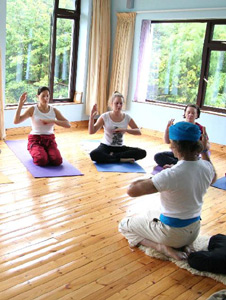 (NaturalNews) Feeling depressed or down? Don't automatically reach for an anti-depressant. Do some yoga. These days, the typical treatment for depression comes in the form of a pill, which can often lead to serious side effects and dependency. Prior to modern drug companies, however, sages from the East discovered a method of calming the mind and soothing the spirit. These physical exercises, called "asanas," are what modern Westerners typically think of when they hear the term "yoga."
(NaturalNews) Feeling depressed or down? Don't automatically reach for an anti-depressant. Do some yoga. These days, the typical treatment for depression comes in the form of a pill, which can often lead to serious side effects and dependency. Prior to modern drug companies, however, sages from the East discovered a method of calming the mind and soothing the spirit. These physical exercises, called "asanas," are what modern Westerners typically think of when they hear the term "yoga."
The roots of yoga date back tens of thousands of years. Yoga, in the grander sense of the word, is not just physical exercise. It is more than asanas. It consists of an entire philosophy and prescription for emotional and spiritual well-being.
"I wish that more people had the level of intensity that Mr. Mike Adams has to get the knowledge in our hands and help us get healthy and stay healthy. I have recommended ALL my friends to sign up for this important newsletter." - Dr. Jack Singh, founder, the Organic Food Bar Company
Yoga asanas (or postures) were developed to prepare the body and mind for long periods of meditation. Ancient yogis believed that it was difficult to reach heights of spiritual awareness with a body that was suffering from ill health. The mind also needed to become calm and serene, and this was accomplished through the physical practice of asana.
Through trial and error over thousands of years, yoga evolved to become a powerful and effective mind/body practice. Thus, yoga is a special form of exercise specifically designed to calm the mind and reduce mental chatter and worry. Certainly, you might feel some stress relief from jogging or tennis, but yoga, unlike most western forms of exercise, was actually designed to create a sense of peace and serenity.
Western studies have shown that regular exercise can provide relief from depression. In addition, yoga postures have been specifically shown to increase levels of the neurotransmitter GABA, which may alleviate depression. Furthermore, as many enthusiastic practitioners of yoga will tell you, yoga seems to go beyond the benefits of general exercise and helps increase overall happiness.
How does yoga improve mental health?
On a physical level, yoga postures are designed to massage the internal organs, increasing and decreasing blood flow to targeted areas. This circulates the blood and lymph, thus removing stale bodily fluids from vital organs and helping flush toxins. The physical movement can also stimulate certain hormones and neurotransmitters, leading to positive feelings and emotions.
Additionally, according to the Eastern medical model, yoga exercises are also designed to specifically move the "prana" or life force energy in the body (traditional Oriental medicine calls this "chi"). Keeping this life force fresh and alive is vital to well-being, according to Eastern philosophy.
Yoga poses stimulate certain aspects of the body's energetic system, comprised of "chakras" (energy centers) and "nadis" (the yogic term for "meridians" or energy channels). As stuck prana is moved and energized, old emotional wounds manifesting as blockages in the energy centers and channels can be released. This may explain why so many yoga practitioners experience a sense of emotional release from practicing certain poses, such as a spontaneous expression of tears, providing a sense of extreme relief and peace afterwards.
The special breathing exercises that go along with yoga (called "pranayama") also serve to energize the body by bringing fresh quantities of prana in through the breath. These breathing exercises can also alleviate anxiety and create a sense of calm and well-being. What type of yoga should you use for depression?
What type of yoga should you use for depression?
Not all yoga is the same. Since its introduction to the West, yoga has branched off into a variety of styles and flavors. The type of yoga you choose should reflect your physical requirements as well as your spiritual interests.
Some kinds of yoga are very physically strenuous and can potentially create more stress if you are in a class where everyone is powering through a challenging set, leaving you feeling inadequate or overwhelmed. Yoga styles such as power yoga or ashtanga can be quite physically challenging. Yoga flow classes may be more about losing pounds and sweating out calories than creating mental peace and clarity. Unless you are already an athlete and looking for a strenuous workout, you might consider trying a more relaxed style.
If you are just starting out with yoga, you might try a beginner's yoga class or a gentle yoga class. Restorative yoga classes can be wonderfully rejuvenating; they consist of gentle poses, often using bolsters and props to allow you to rest and relax in the pose.
Kundalini yoga is a form of yoga that involves dynamic, repetitive movements and breath work to move the energy and lift the spirit. It is the only form of yoga that specifically targets certain glands in the brain, such as the pituitary and the pineal glands, to activate them for improved health and well-being. (For an excellent book on the subject, see Meditation as Medicine by Dharma Singh Khalsa, M.D. and Cameron Stauth.)
Ideally, if you are looking to yoga to improve mental health, consider finding a class that combines some meditation before or after the postures. Meditation has also been shown to increase positive emotions such as loving-kindness and happiness in some studies.
With the variety of yoga styles available, you may have to try out a few different classes to see what appeals to you the most. Do not be discouraged if you aren't immediately drawn to the first class you attend. Be aware that not all yoga classes are equal. Some classes include pranayama breath work and others do not. Some include chanting and others do not. You may even find yoga classes in your area specifically for Christians, while others may be more secular. It's a good idea to check out a few studios and classes and find the one that resonates with you the most.
Remember, yoga alone cannot cure depression if you are otherwise treating your body and your mind badly. Alcohol, drug use (including mind-altering prescription drugs), poor diet, lack of sleep, and other bad habits can negate the positive effects of yoga.
Doing yoga regularly will also make a huge difference in its effectiveness. Ideally, practice yoga for at least 20 minutes daily, or at a minimum three times per week. You can supplement outside yoga classes with a simple, at-home practice. With the popularity of yoga soaring, DVDs and books on yoga are plentiful.
There's a reason why people who practice yoga often credit it for changing their lives. Unlike no other exercise on the planet, yoga provides physical as well as emotional benefits that can create true happiness and well-being. Best of all, you can do it at home for free, with no negative side effects.
About the author: Stephanie Brail is a wellness coach, healer and hypnotherapist.
She provides information and perspectives on alternative health, well-being, spirituality, and more at www.feelgoodgirl.com.

